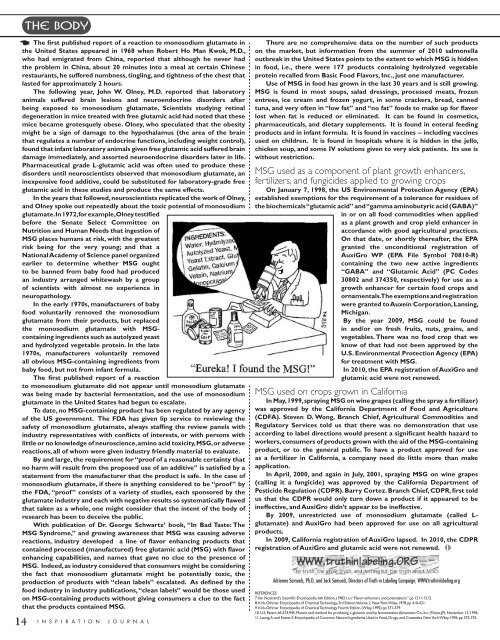Aloha Aloha - Inspiration Journal Magazine
Aloha Aloha - Inspiration Journal Magazine
Aloha Aloha - Inspiration Journal Magazine
You also want an ePaper? Increase the reach of your titles
YUMPU automatically turns print PDFs into web optimized ePapers that Google loves.
14<br />
the body<br />
*<br />
The first published report of a reaction to monosodium glutamate in<br />
the United States appeared in 1968 when Robert Ho Man Kwok, M.D.,<br />
who had emigrated from China, reported that although he never had<br />
the problem in China, about 20 minutes into a meal at certain Chinese<br />
restaurants, he suffered numbness, tingling, and tightness of the chest that<br />
lasted for approximately 2 hours.<br />
The following year, John W. Olney, M.D. reported that laboratory<br />
animals suffered brain lesions and neuroendocrine disorders after<br />
being exposed to monosodium glutamate. Scientists studying retinal<br />
degeneration in mice treated with free glutamic acid had noted that these<br />
mice became grotesquely obese. Olney, who speculated that the obesity<br />
might be a sign of damage to the hypothalamus (the area of the brain<br />
that regulates a number of endocrine functions, including weight control),<br />
found that infant laboratory animals given free glutamic acid suffered brain<br />
damage immediately, and assorted neuroendocrine disorders later in life.<br />
Pharmaceutical grade L-glutamic acid was often used to produce these<br />
disorders until neuroscientists observed that monosodium glutamate, an<br />
inexpensive food additive, could be substituted for laboratory-grade free<br />
glutamic acid in these studies and produce the same effects.<br />
In the years that followed, neuroscientists replicated the work of Olney,<br />
and Olney spoke out repeatedly about the toxic potential of monosodium<br />
glutamate. In 1972, for example, Olney testified<br />
before the Senate Select Committee on<br />
Nutrition and Human Needs that ingestion of<br />
MSG places humans at risk, with the greatest<br />
risk being for the very young; and that a<br />
National Academy of Science panel organized<br />
earlier to determine whether MSG ought<br />
to be banned from baby food had produced<br />
an industry arranged whitewash by a group<br />
of scientists with almost no experience in<br />
neuropathology.<br />
In the early 1970s, manufacturers of baby<br />
food voluntarily removed the monosodium<br />
glutamate from their products, but replaced<br />
the monosodium glutamate with MSGcontaining<br />
ingredients such as autolyzed yeast<br />
and hydrolyzed vegetable protein. In the late<br />
1970s, manufacturers voluntarily removed<br />
all obvious MSG-containing ingredients from<br />
baby food, but not from infant formula.<br />
The first published report of a reaction<br />
to monosodium glutamate did not appear until monosodium glutamate<br />
was being made by bacterial fermentation, and the use of monosodium<br />
glutamate in the United States had begun to escalate.<br />
To date, no MSG-containing product has been regulated by any agency<br />
of the US government. The FDA has given lip service to reviewing the<br />
safety of monosodium glutamate, always staffing the review panels with<br />
industry representatives with conflicts of interests, or with persons with<br />
little or no knowledge of neuroscience, amino acid toxicity, MSG, or adverse<br />
reactions, all of whom were given industry friendly material to evaluate.<br />
By and large, the requirement for “proof of a reasonable certainty that<br />
no harm will result from the proposed use of an additive” is satisfied by a<br />
statement from the manufacturer that the product is safe. In the case of<br />
monosodium glutamate, if there is anything considered to be “proof” by<br />
the FDA, “proof” consists of a variety of studies, each sponsored by the<br />
glutamate industry and each with negative results so systematically flawed<br />
that taken as a whole, one might consider that the intent of the body of<br />
research has been to deceive the public.<br />
With publication of Dr. George Schwartz’ book, “In Bad Taste: The<br />
MSG Syndrome,” and growing awareness that MSG was causing adverse<br />
reactions, industry developed a line of flavor enhancing products that<br />
contained processed (manufactured) free glutamic acid (MSG) with flavor<br />
enhancing capabilities, and names that gave no clue to the presence of<br />
MSG. Indeed, as industry considered that consumers might be considering<br />
the fact that monosodium glutamate might be potentially toxic, the<br />
production of products with “clean labels” escalated. As defined by the<br />
food industry in industry publications, “clean labels” would be those used<br />
on MSG-containing products without giving consumers a clue to the fact<br />
that the products contained MSG.<br />
i n s p i r a t i o n j o u r n a l<br />
There are no comprehensive data on the number of such products<br />
on the market, but information from the summer of 2010 salmonella<br />
outbreak in the United States points to the extent to which MSG is hidden<br />
in food, i.e., there were 177 products containing hydrolyzed vegetable<br />
protein recalled from Basic Food Flavors, Inc., just one manufacturer.<br />
Use of MSG in food has grown in the last 30 years and is still growing.<br />
MSG is found in most soups, salad dressings, processed meats, frozen<br />
entrees, ice cream and frozen yogurt, in some crackers, bread, canned<br />
tuna, and very often in “low fat” and “no fat” foods to make up for flavor<br />
lost when fat is reduced or eliminated. It can be found in cosmetics,<br />
pharmaceuticals, and dietary supplements. It is found in enteral feeding<br />
products and in infant formula. It is found in vaccines -- including vaccines<br />
used on children. It is found in hospitals where it is hidden in the jello,<br />
chicken soup, and some IV solutions given to very sick patients. Its use is<br />
without restriction.<br />
MSG used as a component of plant growth enhancers,<br />
fertilizers, and fungicides applied to growing crops<br />
On January 7, 1998, the US Environmental Protection Agency (EPA)<br />
established exemptions for the requirement of a tolerance for residues of<br />
the biochemicals “glutamic acid” and “gamma aminobutyric acid (GABA)”<br />
in or on all food commodities when applied<br />
as a plant growth and crop yield enhancer in<br />
accordance with good agricultural practices.<br />
On that date, or shortly thereafter, the EPA<br />
granted the unconditional registration of<br />
AuxiGro WP (EPA File Symbol 70810-R)<br />
containing the two new active ingredients<br />
“GABA” and “Glutamic Acid” (PC Codes<br />
30802 and 374350, respectively) for use as a<br />
growth enhancer for certain food crops and<br />
ornamentals. The exemptions and registration<br />
were granted to Auxein Corporation, Lansing,<br />
Michigan.<br />
By the year 2009, MSG could be found<br />
in and/or on fresh fruits, nuts, grains, and<br />
vegetables. There was no food crop that we<br />
know of that had not been approved by the<br />
U.S. Environmental Protection Agency (EPA)<br />
for treatment with MSG.<br />
In 2010, the EPA registration of AuxiGro and<br />
glutamic acid were not renewed.<br />
MSG used on crops grown in California<br />
In May, 1999, spraying MSG on wine grapes (calling the spray a fertilizer)<br />
was approved by the California Department of Food and Agriculture<br />
(CDFA). Steven D. Wong, Branch Chief, Agricultural Commodities and<br />
Regulatory Services told us that there was no demonstration that use<br />
according to label directions would present a significant health hazard to<br />
workers, consumers of products grown with the aid of the MSG-containing<br />
product, or to the general public. To have a product approved for use<br />
as a fertilizer in California, a company need do little more than make<br />
application.<br />
In April, 2000, and again in July, 2001, spraying MSG on wine grapes<br />
(calling it a fungicide) was approved by the California Department of<br />
Pesticide Regulation (CDPR). Barry Cortez. Branch Chief, CDPR, first told<br />
us that the CDPR would only turn down a product if it appeared to be<br />
ineffective, and AuxiGro didn’t appear to be ineffective.<br />
By 2009, unrestricted use of monosodium glutamate (called Lglutamate)<br />
and AuxiGro had been approved for use on all agricultural<br />
products.<br />
In 2009, California registration of AuxiGro lapsed. In 2010, the CDPR<br />
registration of AuxiGro and glutamic acid were not renewed.<br />
Adrienne Samuels, Ph.D. and Jack Samuels, Directors of Truth in Labeling Campaign, WWW.truthinlabeling.org<br />
REFERENCES<br />
7. Van Nostrand’s Scientific Encyclopedia, 6th Edition, (1983.) s.v. “Flavor enhancers and potentiators.” pp 1211-1212.<br />
8. Kirk-Othmer Encyclopedia of Chemical Technology, 3rd Edition, Volume 2. New York: Wiley, 1978. pp 410-421.<br />
9. Kirk-Othmer Encyclopedia of Chemical Technology Fourth Edition (Wiley, 1992) pp 571-579.<br />
10. U.S. Patent #5,573,945. Mutant and method for producing L-glutamic acid by fermentation. Ajinomoto Co., Inc. (Tokyo, JP). November 12, 1996.<br />
11. Leung, A. and Foster, S. Encyclopedia of Common Natural Ingredients Used in Food, Drugs, and Cosmetics. New York: Wiley, 1996. pp 373-375.





